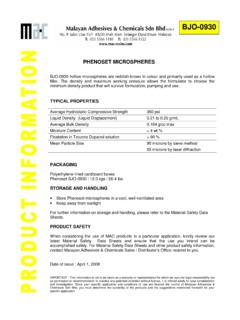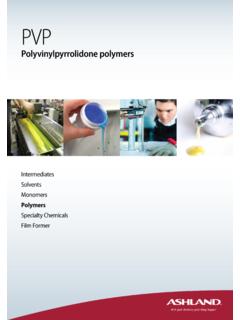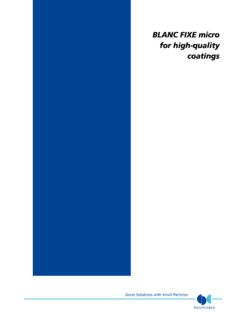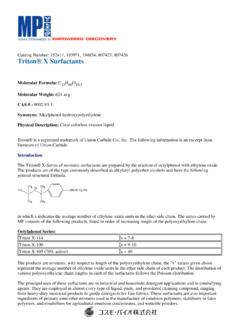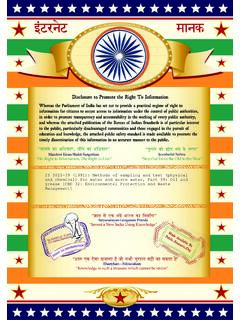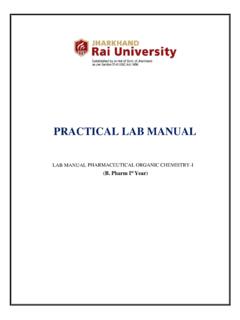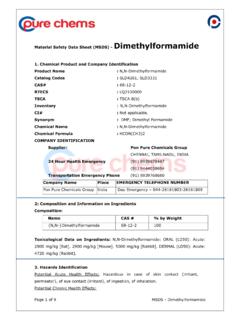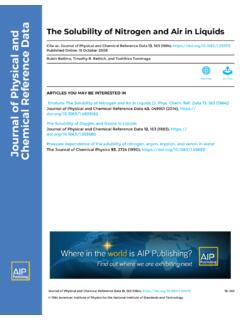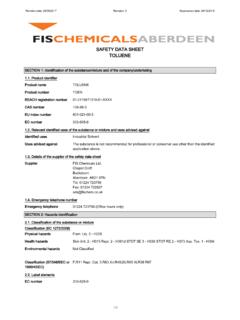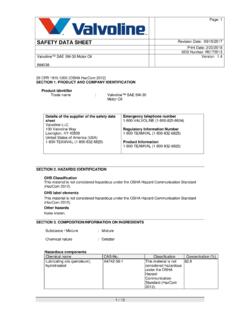Transcription of PVP - Brenntag
1 With good chemistry great things happen. PVPP olyvinylpyrrolidone polymersIntermediates solvents Monomers PolymersSpecialty ChemicalsFilm Former234 Table I: PVP polymers General PropertiesCommercial Types of PVP polymersPVP polymers are available in several viscosity grades, ranging from low to high molecular weight. This range, coupled with solubility in aqueous and organic solvent systems combined with its nontoxic character, are some of the properties that gives PVP polymers great flexibility across multiple applications. The industrial applications of PVP polymers include, for example, in adhesives to improve strength and toughness; in paper manufacture to increase strength and as a coating resin; and in synthetic fibers to improve dye receptivity.
2 PVP polymers are also widely employed in inks, imaging, lithography, detergents and soaps, the textile, ceramic, electrical and metallurgical industries and as a polymerization nonionic polymerHigh polarity/proton acceptorAmphiphilicCompatible with a variety of resins and electrolytesSoluble in water and polar solvents , insoluble in esters, ethers, ketones and hydrocarbonsUnsuitable for thermoplastic processingHard, glossy, transparent, oxygen permeable films which adhere to a variety of substratesHygroscopicAdhesive and cohesive propertiesCross-linkablePhysiologically inertTables I, II and III list the PVP polymers commercially available and some typical properties of the polymers are supplied in various viscosity grades as a powder and/or aqueous solution.
3 The full line of PVP polymers are also available for personal care applications such as film forming, emulsion stabilization and colorant dispersion. Ashland also offers pharmaceutical and agriculture grades of PVP polymer; our Plasdone and Polyplasdone polymer products are used in the pharmaceutical industry, Agrimer polymers are used by the Agriculture Types of PVP polymers ..4 Physical and Chemical Properties ..6 Molecular Weight Determination ..6 Viscosity ..6 Solubility ..9 Film-Forming Properties ..10 Compatibility ..10 Protective-Colloid Action ..12 Complex Formation/Crosslinking ..12 Stability.
4 12 Industrial Application of PVP polymers ..135 Table II: PVP polymer Solution and Powder ProductsPropertyP V P K-12P V P K-15 PVP K-30 PVP K-60 PVP K-90P V P K-120 Appearance @ 25 COff-white amorphous powderPale yellow aqueous solutionOff-white amorphous powderColorless to pale yellow aqueous solutionOff-white amorphous powderYellow aqueous solutionYellow viscous, aqueous solutionOff-white, amorphous powderColorless to yellow aqueous solutionOff-white, amorphous powder K-Value (Viscosity of 1% solution)10 -14a13 -19a13 -19a27-3326 -3550-628 0 -10 09 0 -10 0110 -13 010 8 -130 Color (APHA)<50a4 max.
5 (VCS)10 0 ma x .80 0 -3195 -2495 - 1395 -725 -715 - 805 (combustion)< . 0125 . (5% aqueous solution)3-56-93-76-93-73-74-93-76-94-8 Brookfield Viscosity, cps (5% solids @ 25 C)--1-310-150-350 Specific Gravity @ 25 C-1. 0 Density (g/cc) Density (g/cc) ---Freezing Point C-- Heat (cal/g/KC)-0. polymer GradeK-ValueMolecular Weight (g/mol)Tg ( C )Radius of Hydration (GPC, nm)Radius of Gyration (MALS, nm)RH Triple DetectionRH DLSRg (18 angles)Rg (2 angles)K-1210 144,000 6,000120 2-3 K-1513 196,000 15,00013025 K-3026 3540,000 80,0001636101015K- 6050 62390, 000 470,00017012202123K-8583 88900,000 1,200,00017 2 K-9088 1001,000,000 1,700,00017432495865K-120114 1302,100,000 3,000,00017442606669a 5% aqueous solutionNOTE: This data is typical of current production, but are not necessarily III.
6 PVP polymers properties PVP K-12 and K-15 polymer are too small for accurate MALS size 1: Effect of Concentration of Different Grades of PVP polymer on Viscosity of Aqueous Solutions at 25 C1101001000100001000000102030405060% PVPV iscosity, CentistokesK-120K-90K-60K-30K-15 Physical and Chemical PropertiesMolecular Weight DeterminationThere have been many studies that have been devoted to the determination of the molecular weight of PVP polymer. The low molecular weight polymers have narrower distribution curves of molecular entities than the high molecular weight compounds. Some of the techniques for measuring the molecular weight of various PVP polymer products are based on mea suring sedimentation, light scattering, osmometry, NMR spectroscopy, ebullimometry, and size exclu sion chromatography for determining absolute molecular weight distribution.
7 By the use of these methods, any one of three molecular weight parameters can be measured, namely the number average (Mn), viscosity average (Mv), and weight average (Mw). Each of these characteristics can yield a different answer for the same polymer as illustrated by using these measurement techniques in the analysis of the same PVP K-30 polymer sample. The following results are reported:Number average (Mn) 10,000 Viscosity average (Mv) 40,000 Weight average (Mw) 55,000 Therefore, in any review of the literature, one must know which molecular average is cited. Conventionally, molecular weights are expressed by their K-values, which are derived from relative viscosity K-values assigned to various grades of PVP polymer represent a function of the average molecular weight, the degree of polymerization and the intrinsic viscosity.
8 The K-values are derived from viscosity measurements and are calculated according to Fikentscher s formula: The K-value accepted for PVP polymer by pharmacopoeias and other authoritative bodies worldwide is measured by the viscosity technique and calculated by the use of Fikentscher s an aqueous solution PVP K-15 and PVP K-30 polymer, particularly in concentrations below 10%, have little effect on viscosity, whereas K-60 and K-90 considerably influence flow properties (Figure 1). In organic sol vents the viscosity of the solution is related to that of the solvent, Table relc75K021 + +K0K = 1000K0where c = concentration in g/100 ml solution rel = viscosity of the solutioncompared with solvent7 Table IV.
9 Viscosities of PVP K-30 polymers in Various Organic SolventsKinematic Viscosities (in centistokes)Solvent2% PVP10% PVPA cetic Acid (glacial) 2 121,4-Butanediol101 425 Butyrolactone 2 8 Cyclohexanol 80 376 Diacetone Alcohol 5 22 Diethylene Glycol 39 165 Ethanol (absolute) 2 6 Ethyl Lactate 4 18 Ethylene Glycol 24 95 Ethylene Glycol Monoethyl Ether 3 12 Kinematic Viscosities (in centistokes)Solvent2% PVP10% PVPG lycerin 480 2,046 Isopropanol 4 12 Methyl Cyclohexanone3 10N-Methyi-2-Pyrrolidone 2 8 Methylene Chloride1 3 Monoethanolamine27 83 Nitroethane 1 3 Nonylphenol 3,300 -Propylene Glycol 66 261 Triethanolamine 156 666 Note: Kinematic Viscosity in centistokes = Absolute Viscosity in centsitokes DensityPVP polymer solution viscosity does not change appreciably over a wide pH range, but increases in concentrated HCI.
10 Strong caustic solutions precipitate the polymer, but this precipitate solution redissolves on dilution with water (Table V).Table V: Effect of pH on Viscosity of 5% Aqueous PVP K-30 polymer at 25 HCIV iscosity (cp) densities of PVP polymer water solutions are only slightly changed despite a significant increase in the concentration of PVP K-30 polymer, Table VI: Effect of PVP K-30 polymer Concentration on Density in WaterPVP Concentration (%)1020304050 Density at 2s c (g/ml) effect of temperature and concentration on viscosity is shown in Figures 2 and 3 for PVP K-30 and K-90 polymer respectively.


